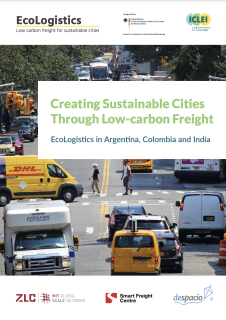
While only 21 percent of the Nationally Determined Contributions (NDCs) highlighting transport refer to freight transport, there is an increasing awareness and focus on sustainable freight at the national and local level. Worldwide more than 500 companies have committed to science-based targets and over 1,000 are taking science-based climate actions. However, greenhouse gas (GHG) emissions from freight transport are increasing continuously and reversing this trend is a particular challenge. Without intervention, freight demand is expected to triple and its associated carbon dioxide (CO2) emissions to more than double by 2050 compared to the 2015 levels.
Against this backdrop, the purpose of this report is to review existing urban freight movement characteristics across nine EcoLogistics project cities in Argentina, Colombia, and India, provide an account of current GHG emissions from urban freight and to evolve strategies to minimize its impact. The report is designed to be used as a baseline from which to measure emissions reductions, and will be used as part of the Low Carbon Action Plan for Urban Freight (LCAPUF), which details the actions that are planned in order to curtail energy consumption and emissions from urban freight. In alignment of global efforts on carbon accounting for logistics operations, the baseline emissions have been established using ICLEI’s EcoLogistics Self-monitoring Tool – a free tool to help cities build policies, guide solutions, and measure progress.
